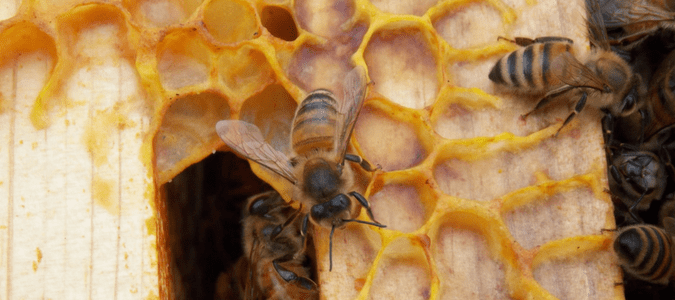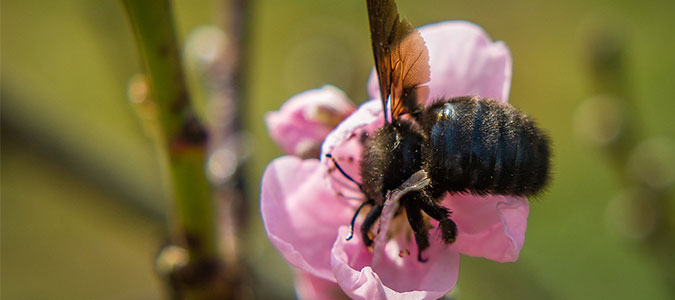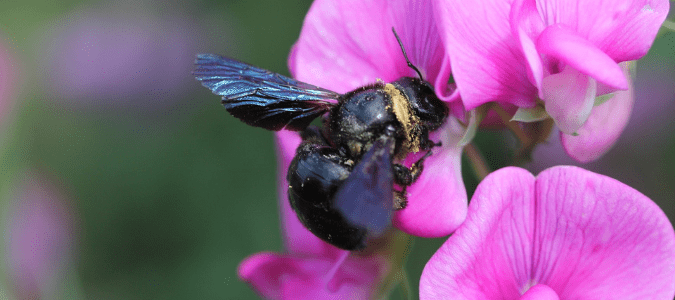When the days get shorter and nights get colder in the fall, you’ll see honey bees out, checking the flowers for some pollen. Then one day, they’re gone, and you really don’t notice until one of those warmer winter days, and you spot a few buzzing around trash. They’ll vanish again until the earliest days of spring when they’re suddenly everywhere. So where are the bees when you don’t see them around in winter?
The answer depends on what kind of bees you’re talking about. There are about 4,000 native bee species in the United States and 20,000 species worldwide. We rarely (if ever) see most of them, of course.
Lots of folks have trouble distinguishing between bees and other stinging insects. The simplest way to tell them apart is to remember that bees tend to be hairy, while wasps and hornets do not. That’s because bees collect pollen from flowers. Bees eat nectar for carbohydrates and pollen for protein. The other stinging insects generally eat other insects for protein.
That distinction may be lost if you or someone you love is allergic to stings. Bees and wasps, like paper wasps, can benefit the environment by pollinating flowers and killing other pests. But no amount of pollination is worth risking your safety. If allergic reactions concern you, don’t try to deal with stinging insects yourself. Instead, contact a pest control expert to handle bees and other pests.
Honey Bees in Winter
But where exactly do bees go in winter? Honey bees hole up in their hive. They can’t fly unless the temperature is above about 50 degrees. When it’s cold, they stay inside in a big ball. Honey bees have small organs on their chests that they can use to generate heat. They spend all winter eating honey and keeping warm. They slowly migrate from the outside of the ball to the inside. That way, everyone takes a turn being cool and then moves into the warmth. The queen stays permanently at the center of the ball at a toasty 93 degrees.
That’s why you sometimes see beekeepers wrap insulation around their hives. If they can hold warmth in, the bees eat less honey and have a better chance of survival. The hive can starve to death if the bees run out of honey before the spring flowers arrive. On those warm days during the winter, there are no flowers to speak of, so bees will go out looking for sources of sugar. In the modern world, that often means garbage. Discarded soda cans are a favorite.
Bumblebees in Winter
Bumblebees are social insects like honey bees, but the similarities end here. Only queen bumblebees survive the winter. Of the maybe 500 bees in a bumblebee colony, she is the only one to make it to frost. Bumblebees nest underground, often in old rodent tunnels. They don’t build their nests themselves. Bumblebees create honey, and the queens use it to survive the winter, but there is very little honey in a nest. Once temperatures hit 50 degrees in spring, the queen will start laying eggs. Within days, a new generation of workers starts making the rounds to find nectar.
Bumblebees aren’t very aggressive unless you threaten their nest. Unfortunately, there’s no way to spot a nest unless you notice bumblebees coming out of a hole in the ground. If you disturb their nest entrance, bumblebees can become dangerous. Contact a reputable pest control company if you spot a bumblebee nest on your property.
Mason Bees in Winter
Mason bees are quite different from honey bees. Mason bees are solitary instead of communal. They live in small holes in things like bamboo or holes bored in wood by other insects. They’re known as mason bees because they cap their holes with mud. Wild mason bees spend their winters as larvae in their tubes. Like honey bees, they wait for the 50-degree days of spring. Once they hatch, they set about mating and eating. Mason bees have a weak sting, and unlike honey bees, they can sting repeatedly, though they almost never do. Mason bees are not very aggressive. Their larvae are sold to people who want to bring them into their gardens.
Carpenter Bees in Winter
Carpenter bees actually do hibernate. Unfortunately, they may hibernate in your house’s wood eaves or exposed beams. Carpenter bees are not aggressive, but they can cause damage to your home. They’re solitary bees. Each bee will dig a finger-sized hole into the underside of a piece of wood. This hole is about an inch deep but turns 90 degrees and runs another five or six inches. They will raise a few babies in the hole, and one will winter in it while the others dig new ones.
Holes of this size have the potential to weaken elements of your home. Check with a pest control professional if you see large bees buzzing around wood beams in your house.
Squash Bees, Leafcutter Bees, and Sweat Bees in Winter
These bees are common but not known for stinging. All three of these bees nest either in the ground or rotting wood. You’ll see squash and leafcutter bees around your flowers. Leafcutters can actually damage your flowers. They cut out little round pieces of flower petals to line their nests. Sweat bees are usually very small and may look metallic. They will sometimes fly around you or even land on you to take a drink of sweat, but they have no interest in stinging unless you slap them.
How Long Do Bees Live?
Honey bees born in the spring and summer don’t live very long. Worker bees may survive six weeks. They basically work themselves to death. Male honeybees are known as drones. They can’t sting and don’t do any work. They sit around, eat honey, and hope to mate with any new queens raised by the hive. Come fall, the drones are driven out of the hive to die in the cold. Queens can live three or four years on average. They only leave the hive to mate and then again to lead a swarm to form a new colony elsewhere.
The queen is the only bumblebee that survives the winter, while carpenter bees hibernate and mason bees survive as pupae. That means in the cooler months, even on warm days, honey bees are really the only bee you’ll see out and about.
Keeping Bees Away
Bees are ubiquitous, and it’s difficult to keep them away. However, you can take some steps to make your property less appealing to them.
Honey Bees
Honey bees swarm in April, May or June to find new homes. This often happens right after a good rain. The queen will leave with a few thousand bees and spend a day or so hanging under a limb or somewhere nearby while scouts search for a permanent location. Swarms are not aggressive at all, though they look scary. Honey bees will set up housekeeping in your house if they find the right conditions.
The scouts watch for small openings in empty cavities. Repairing any holes or gaps in your home’s siding is important. Bees also need space, so they look for uninsulated walls and soffits. Contact a pest control exterminator who can ensure you have ample insulation in your exterior walls and eaves.
Carpenter Bees
You can deter carpenter bees by keeping wooden elements painted or varnished. They will chew through latex paint, but they’ll pass over wood with a good oil-based coating or polyurethane varnish.
Mason Bees
Mason bees look for tubes. Pieces of bamboo make great homes for mason bees, so keeping river cane and bamboo off your property will encourage them to go elsewhere.
Other Bees
Bees are almost universally attracted to flowers for nectar and pollen. You might think that means you can’t have flowers on your property, but many flowers are not pollinated by bees.
There are also flowers that are fertilized by birds. Orioles, hummingbirds, and white-wing doves all drink nectar from flowers. Many cacti are pollinated by birds. Watch for flowers with long throats that require long tongues to reach the nectar. Good candidates include:
- Larkspur
- Bergamot
- Scarlet gilia
- Cardinal flower
- Trumpet honeysuckle
- Manzanita
- Penstemon
More flowers are fertilized by moths than bees. Many of those bloom at night when moths are out. Moonflowers are dramatic after dark, with their hand-sized white flowers growing on deep green vines. Petunias are related to moon flowers but bloom during the day, as do these other choices:
- Monarda
- Gentian
- Raspberries
- Foxglove
- Heliotrope
- Primrose
- Four O’Clocks
- Salvia
Do Bees Fly in the Dark?
There’s another reason to look into gardens that really shine in the early morning and evening. Bees don’t fly at night. Since they navigate by the sun, they bed down reliably by sunset.
You can deter bees and maintain a beautiful lawn and garden. Still, if bees find something attractive about your property, it’s never a good idea to try eliminating them yourself. They can, after all, defend themselves. Additionally, it’s difficult to reach them if they get established in a wall or eave of your house. Then the honeycomb has to be removed to prevent the stored honey from attracting countless other pests.
Clearing out bumblebee nests is also beyond the capabilities of most people because they can run several feet deep. Professional Pest control exterminators know how to minimize damage to your home during the removal and to control them safely.
ABC Can Get Rid of Your Bee Issues
Seeing bees or a nest on your property can be frightening. Instead of trying to handle the bee problem on your own, contact ABC Home & Commercial Services. Our pest control professionals can effectively remove these pests, so you don’t have to worry about painful stings. They can also help you distinguish between a bee hive and a wasp nest.


